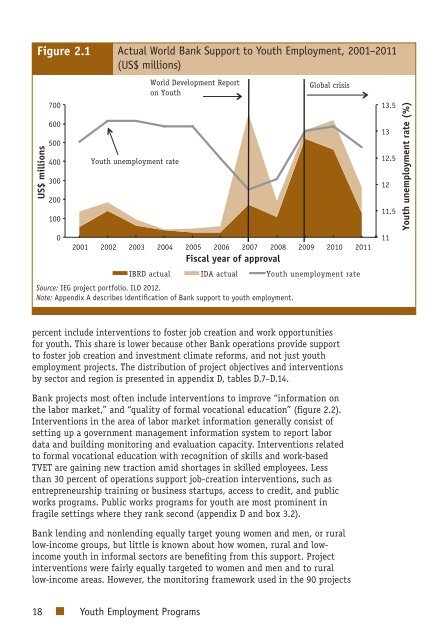Youth Employment Programs - Independent Evaluation Group
Youth Employment Programs - Independent Evaluation Group
Youth Employment Programs - Independent Evaluation Group
Create successful ePaper yourself
Turn your PDF publications into a flip-book with our unique Google optimized e-Paper software.
Figure 2.1 Actual World Bank Support to <strong>Youth</strong> <strong>Employment</strong>, 2001–2011(US$ millions)US$ millions7006005004003002001000<strong>Youth</strong> unemployment rateWorld Development Reporton <strong>Youth</strong>Source: IEG project portfolio. ILO 2012.Note: Appendix A describes identification of Bank support to youth employment.Global crisis2001 2002 2003 2004 2005 2006 2007 2008 2009 2010 2011Fiscal year of approvalIBRD actual IDA actual <strong>Youth</strong> unemployment rate13.51312.51211.511<strong>Youth</strong> unemployment rate (%)percent include interventions to foster job creation and work opportunitiesfor youth. This share is lower because other Bank operations provide supportto foster job creation and investment climate reforms, and not just youthemployment projects. The distribution of project objectives and interventionsby sector and region is presented in appendix D, tables D.7–D.14.Bank projects most often include interventions to improve “information onthe labor market,” and “quality of formal vocational education” (figure 2.2).Interventions in the area of labor market information generally consist ofsetting up a government management information system to report labordata and building monitoring and evaluation capacity. Interventions relatedto formal vocational education with recognition of skills and work-basedTVET are gaining new traction amid shortages in skilled employees. Lessthan 30 percent of operations support job-creation interventions, such asentrepreneurship training or business startups, access to credit, and publicworks programs. Public works programs for youth are most prominent infragile settings where they rank second (appendix D and box 3.2).Bank lending and nonlending equally target young women and men, or rurallow-income groups, but little is known about how women, rural and lowincomeyouth in informal sectors are benefiting from this support. Projectinterventions were fairly equally targeted to women and men and to rurallow-income areas. However, the monitoring framework used in the 90 projects18 <strong>Youth</strong> <strong>Employment</strong> <strong>Programs</strong>
















